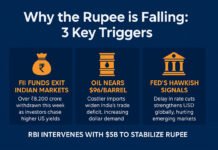Indian Rupee Plummets to Historic Low Amid Economic Uncertainty
The Indian rupee has witnessed a sharp decline, breaching the 87+-per-dollar mark for the first time in history. This unprecedented slump in the currency market is fueled by concerns over US tariff hikes, capital outflows, and global economic volatility. As the rupee continues to depreciate, it raises significant concerns for businesses, investors, and policymakers.
Opening Figures: Rupee Crashes to 87.12 per US Dollar
At the start of currency trading, the Indian rupee opened 42 paise lower at 87.06 per US dollar. Within the first 10 minutes of trading, it plunged further, falling 55 paise to touch a historic low of 87.12 per dollar. The downward momentum is attributed to rising inflation, geopolitical tensions, and tightening monetary policies in the US.
Why Is the Rupee Falling? Major Contributing Factors
The sharp decline in the rupee’s value is a result of multiple economic and geopolitical factors. Here are the primary reasons behind the Indian currency’s downfall:
1. US Tariff Hike Concerns
The possibility of increased US tariffs on Indian exports has created economic uncertainty, triggering a sell-off in Indian assets. Investors fear that higher tariffs could reduce trade volume, weaken the Indian economy, and put pressure on the rupee.
2. Rising US Dollar Strength
The US dollar has been strengthening due to aggressive interest rate hikes by the Federal Reserve. As the Fed continues to raise rates to curb inflation, global investors are flocking to the US dollar as a safe-haven asset, further weakening emerging market currencies like the rupee.
3. Foreign Capital Outflows from Indian Markets
Foreign institutional investors (FIIs) have been withdrawing capital from Indian equity and debt markets, adding to the rupee’s downward pressure. Uncertainty over India’s economic policies, high inflation, and global recession fears have contributed to this capital flight.
4. High Crude Oil Prices
India is a major importer of crude oil, and rising global crude prices have widened the current account deficit. Higher oil prices increase import costs, leading to a higher demand for dollars and a weaker rupee.
5. Widening Trade Deficit
India’s trade deficit has expanded significantly, as imports continue to outpace exports. A wider trade gap means more dollars are needed to pay for imports, adding downward pressure on the rupee.
Impact of the Rupee’s Depreciation on the Economy
The rupee’s freefall has far-reaching implications on various sectors of the economy, affecting businesses, consumers, and policymakers alike.
1. Increased Import Costs
As the rupee weakens, imported goods become more expensive. Essential commodities like oil, electronics, and industrial raw materials are now costlier, leading to higher inflation and increased production costs.
2. Rising Inflationary Pressures
A weaker rupee directly contributes to inflation, as businesses pass on increased import costs to consumers. Essential goods such as fuel, food, and pharmaceuticals will likely see price hikes, further straining household budgets.
3. Impact on Foreign Travel and Education
For Indians traveling abroad or studying in foreign universities, the cost of expenses in USD, EUR, and GBP has surged. Students, tourists, and business travelers will have to shell out more rupees to cover their overseas expenses.
4. Export Sector Gains Some Advantage
While a weak rupee negatively impacts imports, it provides some relief to exporters. Indian goods become cheaper for foreign buyers, making sectors like IT services, textiles, and pharmaceuticals more competitive in global markets.
5. Pressure on RBI to Intervene
The Reserve Bank of India (RBI) is likely to intervene in the foreign exchange market to prevent excessive volatility. The central bank has been using its forex reserves to stabilize the rupee, but prolonged interventions could deplete reserves and limit policy flexibility.














